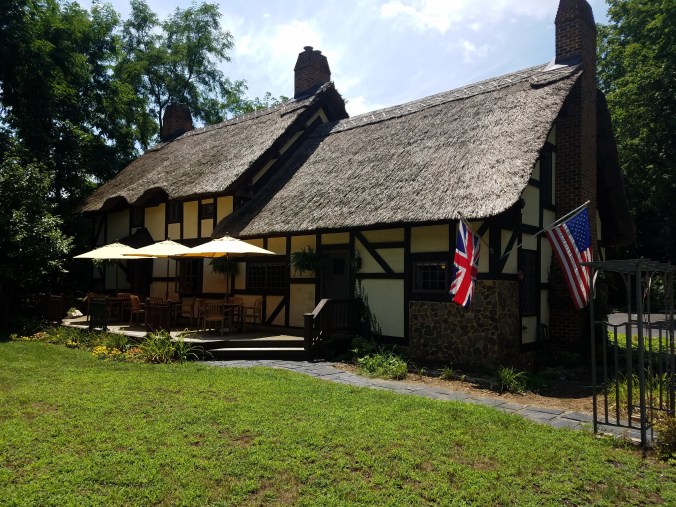When you have your ten-year-old great niece staying for a week, you think about what activities might be fun. On Wednesday we drove to the Science Museum in Richmond especially to see its “Animals Inside Out” exhibit. Kaileena said the best part of that outing was, you guessed it, the tightrope!

I asked her what else she liked that day and she did not hesitate in the least: the cartwheels on the back deck that she did when we got home! This reminds me of a family I knew who took their two daughters on a special trip to Disney World, and the thing the girls liked best was – yup – the pool at the hotel!
You do what you can. You hope for the best.
On Thursday we drove west. The destination was Beverley’s summer home where Kaileena got to slide down a natural water slide in a rushing mountain stream (a highlight of the week, to be sure). On the way we stopped for lunch at the Anne Hathaway Cottage Tea Room in Staunton. The interior was elegant in an old-world way – stone floor, dark wood fireplace, fine old china decorating the walls – utterly charming. My beet and strawberry salad, with feta cheese and a creamy balsamic dressing, was divine. Mom’s and Kaileena’s sandwiches were equally impressive and delicious: cream cheese and sliced strawberries on one, and ham salad with pineapple on the other. If you want sugar in your tea, you use the small tongs to pinch a lump and drop it in. You can see the tongs hanging off the sugar bowl on the table.

Set back from a fairly main road, almost hidden, the cottage itself looks as authentic as it is. That roof is thatch. In addition to being the most common roofing material worldwide, thatch is apparently making a comeback in higher-end circles on account of being lightweight, versatile and waterproof. A great variety of wild and cultivated grains, including wheat and rye, can be used. The wheat that makes the straw that was historically used for making roofs is the same wheat that gave grain for making bread.

The owner proudly told me that the roof of this cottage in Staunton is likely to last 30+ years.

When I was a child in grade school, we got a little Scholastic Books catalog every now and then, and Mom allowed me to make some choices. One of the books I picked out, which probably cost 25 cents, had a story that included a thatched roof. I could not help but think of that story when I saw this thatched roof. Lines of dialog were etched in my mind. The story affected me hugely and I remember it well, though its title escaped me. Its message undoubtedly helped shape the way I think about wisdom and age to this day.
The book itself did not survive my childhood. As I had children of my own, and they got a little bigger, I reflected often on the part that story had played in my life. Finally, sometime in my thirties, I wrote to the Library of Congress to see if they could help me find it. This was back when you wrote longhand letters on real paper and waited weeks for a reply. This was way before search engines.
I wrote to them what I remembered from the story, a summary as well as some lines of dialog. In less than a month, they sent me a photocopy of the story from an anthology of folk tales. How thrilling it was for me to read the story again, twenty or so years later. Some of the lines I had remembered verbatim.
This is how I remember the story. Maybe it will be as powerful for you as it was for me.
Long ago and far away, there was a rural village where the people had always done things a certain way. They followed their traditions strictly and kept close tabs on each other. For the most part their way of life worked very well.
One of the expectations of life in this village was that you must be productive and useful. When you got too old or feeble to be able to contribute your share of the work, you were put on a sled and brought to the woods in the middle of the winter and left there to die.
In one family, the grandfather was no longer able to work. His legs hurt and he was not strong. His son knew the day had come to follow the tradition of the village, even though he didn’t like the idea. He put his father on the sled and strapped him in. The grandfather said nothing because he knew and accepted the custom. But all the while, the grandson was watching.
“Daddy,” said the little boy. “Are you taking Grandfather out to the woods?”
“Yes, son.”
“Don’t forget to bring the sled back.”
“Why?”
“Because someday I need it to take you to the woods.”
This gave the man pause. The idea of his father – or himself – freezing to death in the cold, dark woods made him want to defy the custom. But he knew that if he did not take him, someone else in the village would do it. The only other choice was to hide the old man.
From that day forward the old grandfather lived in the attic. He could not risk being caught, so he did not make a sound and he could no longer take walks in the street or sit in the full sun. But he lived. His grandson brought him food and drink.
This went on for several years. One spring, the boy began to bring less and less food. When his grandfather asked him why, the boy said, “The crops were so bad. We have only a little food left and we have no seed grain for the next crop. It’s terrible. We all will starve.”
“Something like this happened when I was a little boy too,” the old man said. “Tell your father to take the thatch off the roof and thresh it again. There will be seed in it yet, and that seed will produce a crop.”
The father did what the grandfather suggested, and sure enough, there was seed for the next crop! When his neighbors saw what he did and saw his success, they said, “How did you know there would be seed yet in the thatch?”
The man knew he had to confess. “I didn’t know, but my old father did. How fortunate for all of us that he is still alive. His memory and his wisdom have saved us all.”
After that, the people changed their ways. They did not take their old people out to the woods any more. Instead, they cherished them, honored them and took care of them because now they knew that “useful” is not just about how much you can work.
The little boy was especially proud of his grandfather. Sometimes they would sit together and enjoy the full sun.
Makes you wonder about this generation that often sees no value in the life experience of those who came before, or the grandparents still living. An elderly Japanese man said to a young man “it is difficult to provide drink to one whose cup is already full.” To a generation that already knows the answers…
LikeLike